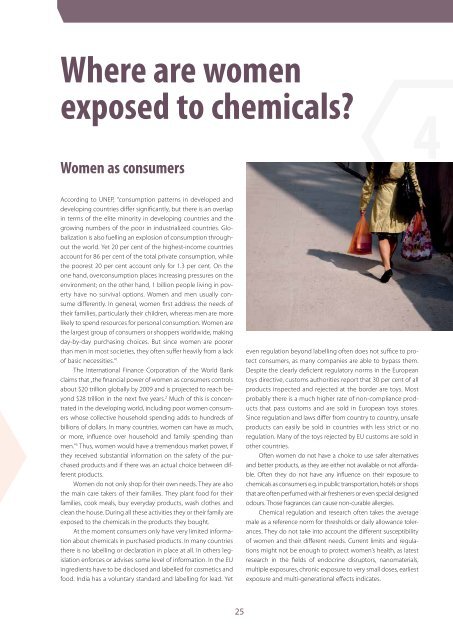Women and Chemicals
1ToENNR
1ToENNR
Create successful ePaper yourself
Turn your PDF publications into a flip-book with our unique Google optimized e-Paper software.
Where are women<br />
exposed to chemicals?<br />
<strong>Women</strong> as consumers<br />
4<br />
According to UNEP, “consumption patterns in developed <strong>and</strong><br />
developing countries differ significantly, but there is an overlap<br />
in terms of the elite minority in developing countries <strong>and</strong> the<br />
growing numbers of the poor in industrialized countries. Globalization<br />
is also fuelling an explosion of consumption throughout<br />
the world. Yet 20 per cent of the highest-income countries<br />
account for 86 per cent of the total private consumption, while<br />
the poorest 20 per cent account only for 1.3 per cent. On the<br />
one h<strong>and</strong>, overconsumption places increasing pressures on the<br />
environment; on the other h<strong>and</strong>, 1 billion people living in poverty<br />
have no survival options. <strong>Women</strong> <strong>and</strong> men usually consume<br />
differently. In general, women first address the needs of<br />
their families, particularly their children, whereas men are more<br />
likely to spend resources for personal consumption. <strong>Women</strong> are<br />
the largest group of consumers or shoppers worldwide, making<br />
day-by-day purchasing choices. But since women are poorer<br />
than men in most societies, they often suffer heavily from a lack<br />
of basic necessities.“ 1<br />
The International Finance Corporation of the World Bank<br />
claims that „the financial power of women as consumers controls<br />
about $20 trillion globally by 2009 <strong>and</strong> is projected to reach beyond<br />
$28 trillion in the next five years. 2 Much of this is concentrated<br />
in the developing world, including poor women consumers<br />
whose collective household spending adds to hundreds of<br />
billions of dollars. In many countries, women can have as much,<br />
or more, influence over household <strong>and</strong> family spending than<br />
men.” 3 Thus, women would have a tremendous market power, if<br />
they received substantial information on the safety of the purchased<br />
products <strong>and</strong> if there was an actual choice between different<br />
products.<br />
<strong>Women</strong> do not only shop for their own needs. They are also<br />
the main care takers of their families. They plant food for their<br />
families, cook meals, buy everyday products, wash clothes <strong>and</strong><br />
clean the house. During all these activities they or their family are<br />
exposed to the chemicals in the products they bought.<br />
At the moment consumers only have very limited information<br />
about chemicals in purchased products. In many countries<br />
there is no labelling or declaration in place at all. In others legislation<br />
enforces or advises some level of information. In the EU<br />
ingredients have to be disclosed <strong>and</strong> labelled for cosmetics <strong>and</strong><br />
food. India has a voluntary st<strong>and</strong>ard <strong>and</strong> labelling for lead. Yet<br />
even regulation beyond labelling often does not suffice to protect<br />
consumers, as many companies are able to bypass them.<br />
Despite the clearly deficient regulatory norms in the European<br />
toys directive, customs authorities report that 30 per cent of all<br />
products inspected <strong>and</strong> rejected at the border are toys. Most<br />
probably there is a much higher rate of non-compliance products<br />
that pass customs <strong>and</strong> are sold in European toys stores.<br />
Since regulation <strong>and</strong> laws differ from country to country, unsafe<br />
products can easily be sold in countries with less strict or no<br />
regulation. Many of the toys rejected by EU customs are sold in<br />
other countries.<br />
Often women do not have a choice to use safer alternatives<br />
<strong>and</strong> better products, as they are either not available or not affordable.<br />
Often they do not have any influence on their exposure to<br />
chemicals as consumers e.g. in public transportation, hotels or shops<br />
that are often perfumed with air fresheners or even special designed<br />
odours. Those fragrances can cause non-curable allergies.<br />
Chemical regulation <strong>and</strong> research often takes the average<br />
male as a reference norm for thresholds or daily allowance tolerances.<br />
They do not take into account the different susceptibility<br />
of women <strong>and</strong> their different needs. Current limits <strong>and</strong> regulations<br />
might not be enough to protect women’s health, as latest<br />
research in the fields of endocrine disruptors, nanomaterials,<br />
multiple exposures, chronic exposure to very small doses, earliest<br />
exposure <strong>and</strong> multi-generational effects indicates.<br />
25


